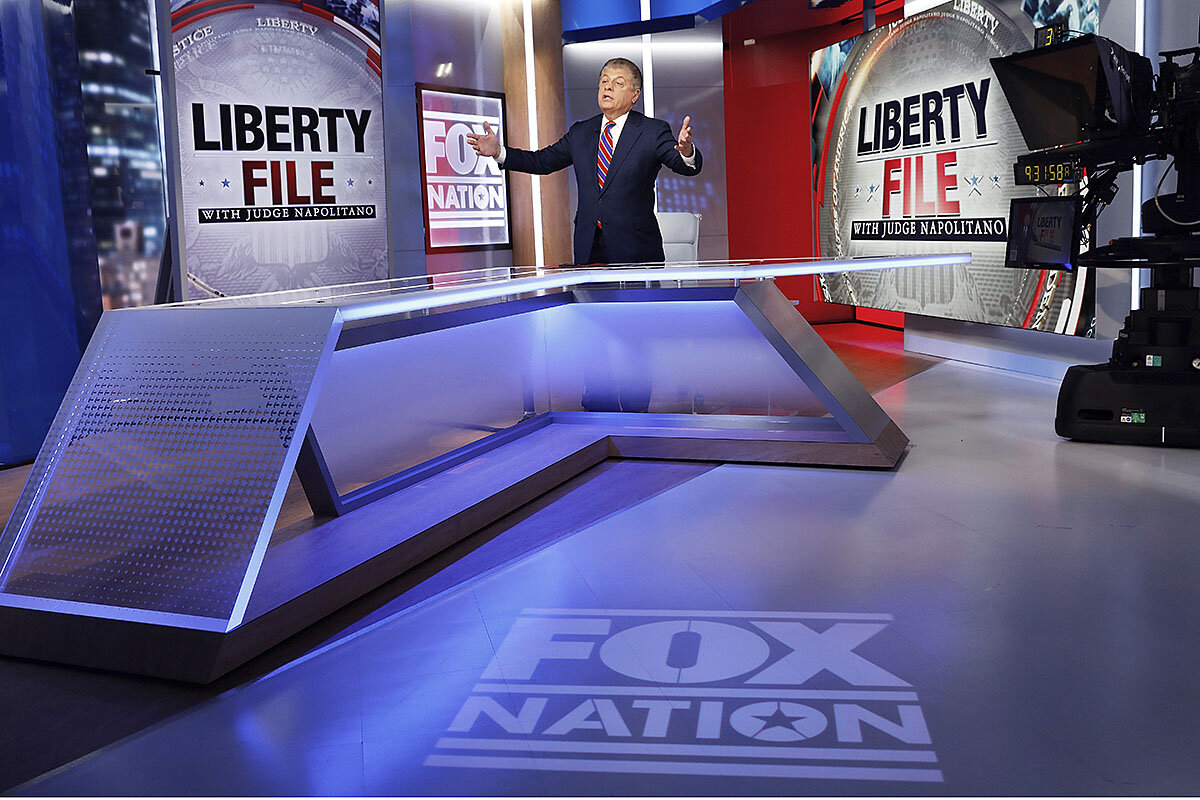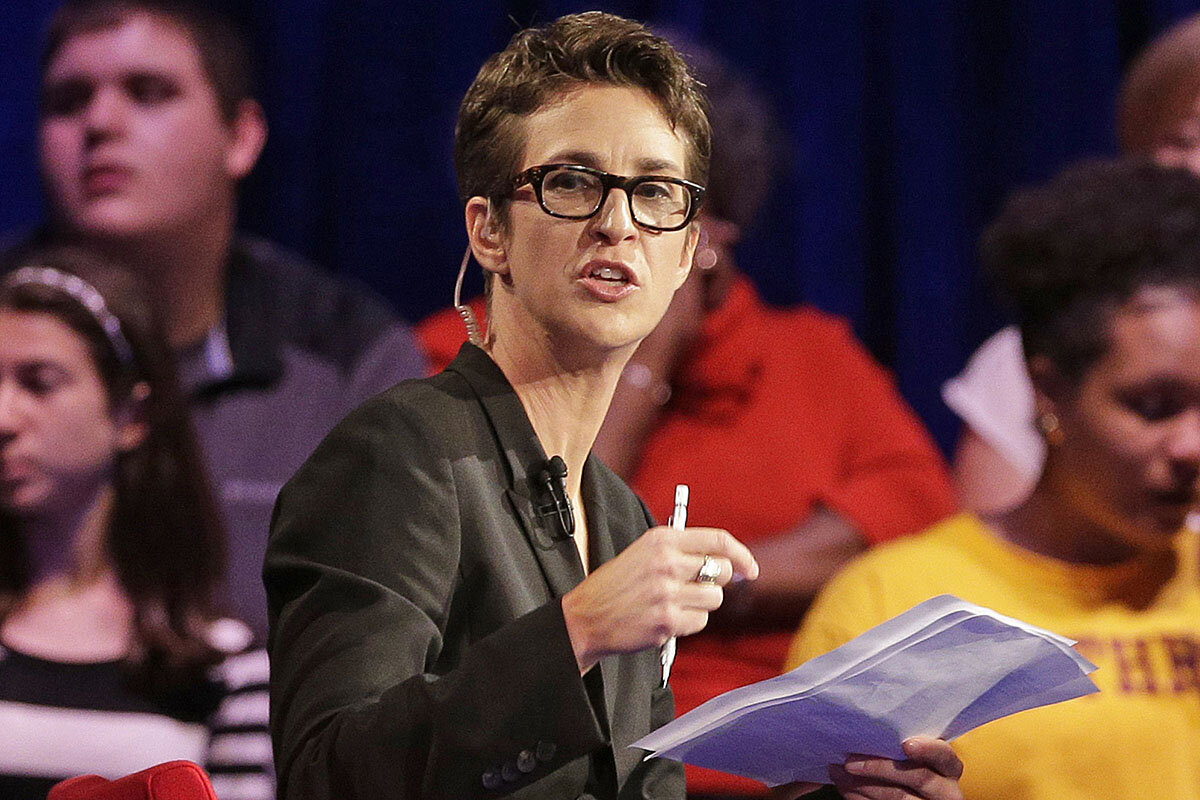Is America’s media divide destroying democracy?
Loading...
Sometimes it seems as if the deepest divide in American politics is not so much between Republicans and Democrats as between voters who watch Fox News, and those who don’t.
For instance, 84% of Fox-viewing Republicans support President Donald Trump‚Äôs declaration of a national emergency to build a border wall, according to a March Navigator Research survey. But among the rest of America ‚Äď including members of the GOP who don‚Äôt watch Fox ‚Äď only 21 percent think the emergency is a good idea.
Splits like this have led to a lot of recent critical examination of Fox’s role in the modern U.S media ecosystem. Critics have called it , and traced the entwining relationships between Fox executives and on-air stars and administration officials and government regulators.
Why We Wrote This
Fox News in the Trump Era has been labeled ‚Äústate TV.‚ÄĚ Conservatives have complained about liberal media bias for decades. Separate media spheres have created separate realities ‚Äď and a growing challenge for unity. Seventh in our ‚ÄúDemocracy Under Strain‚ÄĚ series.
But focusing on the role of one outlet, however big and influential, ignores the larger context of an entire American media ecosystem increasingly divided between an insular conservative wing, and a center-left wing derided and praised as the ‚ÄúMSM‚ÄĚ (mainstream media).
It‚Äôs a partition that produces not so much dual echo chambers as different realities. It‚Äôs not just that the two media spheres have divergent attitudes toward the same stories. Often, they chase different stories entirely ‚Äď which the other side barely hears about at all.
One of the defining aspects of modern politics is that the base voters of the Republican and Democratic parties are consuming entirely different diets of news.Őż
This reality isn’t a phenomenon born in the Age of Trump. Conservative activists have worked with varying degrees of success to create print and broadcast outlets that explicitly promote their beliefs since the 1950s. Their big breakthrough came with the rise of Ronald Reagan. Now they have a powerful sphere of influence that features TV and talk radio stars and increasingly aggressive online sites.
‚ÄúI would not say it is just Fox News. It is that entire conservative media bubble that matters,‚ÄĚ says Nicole Hemmer, an assistant professor at the University of Virginia‚Äôs Miller Center of Public Affairs and author of ‚ÄúMessengers of the Right: Conservative Media and the Transformation of American Politics.‚ÄĚ
‚ÄėGo back to Puerto Rico!‚Äô
To see how America‚Äôs media division can lead to misunderstanding ‚Äď and perhaps worse ‚Äď let‚Äôs take a look at a specific incident that happened on the floor of the House of Representatives in January.
It was in the midst of the government shutdown. Tensions between the parties were high. The House had already adjourned for the week, so C-SPAN cameras were off. Groups of Republicans and Democrats were milling about, and Rep. Tony Cardenas, a California Democrat of Mexican heritage, was waiting to speak.
‚ÄúGo back to Puerto Rico!‚ÄĚ yelled a Republican, later identified as Rep. Jason Smith from Missouri.
Congressman Cardenas and his fellow Democrats were shocked. They thought it was an ethnically tinged slur hurled at a lawmaker who happened to look Hispanic. It was the kind of insult he’d heard as a kid, said Mr. Cardenas.
But that was not the case, Congressman Smith said later in an apology. His barb had been aimed at all the Democrats ‚Äď 30 of whom had spent the previous weekend on a fundraising jaunt in San Juan organized by an arm of the Congressional Hispanic Caucus.
The trip had been heavily covered by conservative media, with the general theme of ‚ÄúDemocrats leave Washington for a tropical boondoggle during the government shutdown.‚ÄĚ But it was barely mentioned on non-conservative outlets ‚Äď and as a result the Democratic lawmakers hadn‚Äôt gotten the reference. (As part of his apology, Mr. Smith said that he and Mr. Cardenas should get to know each other better.)
‚ÄúThat people need this explained suggests that the ‚ÄėDems partied in Puerto Rico‚Äô stuff didn‚Äôt reach escape velocity out of Fox News,‚ÄĚ tweeted Washington Post reporter Dave Weigel at the time.
It‚Äôs far from the only story that didn‚Äôt cross the partisan barrier. ‚ÄúUranium One,‚ÄĚ a story involving then-Secretary of State Hillary Clinton‚Äôs alleged involvement in the sale of American uranium reserves to the Russian state nuclear company was heavily discussed on Fox News, Rush Limbaugh‚Äôs show, and other conservative outlets in 2017. It received much less attention on non-conservative media. Mr. Limbaugh and others saw this as evidence of overt liberal bias. The MSM explanation was that the pieces of the purported conspiracy didn‚Äôt add up.
The Seth Rich murder received similar bifurcated treatment. Mr. Rich, an employee of the Democratic National Committee (DNC), was killed near his Washington apartment on July 10, 2016. Online conspiracy theorists quickly began whispering, without evidence, that the young Democratic operative, not Russia, had leaked a trove of DNC emails to WikiLeaks and paid with his life.
In the spring of 2017 the story exploded onto Fox News, which picked up a piece from a local D.C. affiliate alleging that Mr. Rich had contacted WikiLeaks and that law enforcement was covering up the trail. Popular host Sean Hannity ran numerous prime time segments on this false theory.
But the Rich story soon fell apart in a tangle of recanting sources and false claims. Fox officially retracted it a few days after it first ran. Non-conservative media focused heavily on the case‚Äôs collapse ‚Äď the liberal-leaning Vox site, for instance, ran a post headlined ‚ÄúThe Bonkers Seth Rich Conspiracy Theory ‚Äď Explained.‚ÄĚ
Two separate spheresŐż
What do the courses run by these stories say about the structure of American media today?
What they illustrate is that there is not one media ecosystem, but two separate spheres that respond to different incentives and operate in very different manners, says Yochai Benkler, a professor at Harvard Law School and co-author of ‚ÄúNetwork Propaganda: Manipulation, Disinformation, and Radicalization of American Politics.‚ÄĚ
One of these spheres is comprised of right-leaning media, from Fox News to Breitbart and talk radio hosts such as Mr. Limbaugh. The other is a center-left composite of everything else, from the legacy newscasts of the old broadcast networks to most daily newspapers and new liberal internet sites.
To find out how news moves through these spheres, Professor Benkler and his co-authors used data analysis tools to study hyperlink connections, Facebook shares, and other marking aspects of some 4 million stories from the 2016 U.S. presidential election and the first year of the Trump presidency. Their study showed that right-leaning audiences concentrated to a large extent on right-leaning outlets insulated from the rest of the media. Center and left-leaning audiences spread their attention more broadly and focused in particular on what is often labeled the MSM.
This disparity is driven in part by the fact that the center-left in U.S. politics is a broad spectrum that includes ideological, racial, and ethnic diversity. The right is more ideologically focused and remains predominantly white and ļ£Ĺ«īů…Ů.
‚ÄúYou just don‚Äôt have the same obvious coherence on the left. That‚Äôs the shape of political identity in America,‚ÄĚ says Professor Benkler.
Both sides like to hear news that reaffirms their deeply held beliefs and identities. That‚Äôs just human nature, perhaps unfortunately. Many committed Democrats gravitate toward stories online that promise to expose GOP hypocrisy. Many conservatives chuckle at talk radio hosts who say the ‚ÄúDemocrat Party‚ÄĚ would institute socialism in America ‚Äď if they could only figure out what it is.
On the center-left, such stories are vetted and constrained by the structure of the system. Center-left readers and viewers tend to be exposed to a fairly wide range of outlets, many with strong traditional fact-checking mechanisms.
But on the right, says Professor Benkler, those barriers are weaker or even nonexistent. Smaller, more radical conservative media outlets compete to see who can be more ideologically pure and define the accepted political narrative. The result is what he calls a ‚Äúpropaganda feedback loop‚ÄĚ ‚Äď an insular dynamic in which false information and outright conspiracy theories can thrive.
‚ÄúWe‚Äôre looking at the present state of a system that has really been developing for 40 years,‚ÄĚ he says.
Bias that‚Äôs invisible to liberalsŐż
To conservatives, the defining feature of U.S. media is not ‚Äúfeedback loops‚ÄĚ ‚Äď but left-leaning bias so pervasive that it‚Äôs invisible to liberals.
They‚Äôve felt that way since the early development years of American conservative media in the wake of World War II.ŐżBy the early 1950s, the nation‚Äôs nascent right wing was frustrated and angry with the political status quo in general and the media in particular. The Cold War foreign policy consensus, in which most Democrats and Republicans backed a steady containment of international communism, was weak-kneed, in the conservative view. Why not push for actual victory?
Conservatives of the time were also staunchly anti-union and religious, and they felt neither position received enough attention and support from establishment newspapers and radio networks. Some believed the creation of right-leaning media organizations ‚Äď not just PR efforts ‚Äď was the answer.
‚ÄúThere was a real belief that their ideas just weren‚Äôt in circulation, and that if the ideas got out there, they could trigger conservatism,‚ÄĚ says Dr. Hemmer of the University of Virginia.
Broadcaster Clarence Manion, book publisher Henry Regnery, and magazine publisher William Rusher emerged as new conservative leaders. With their radio shows and book clubs and the newsletter Human Events, they were organizing a movement as much as spreading a doctrine to the larger public.
Along the way, they established some ideological tenets that remain foundational for conservative media today. First, and perhaps most importantly, they insisted that existing media were not just ignoring their concerns about particular issues, but were wearing masks of ‚Äúobjectivity.‚ÄĚ They crafted and popularized the idea of liberal media bias, writes Dr. Hemmer in ‚ÄúMessengers of the Right.‚ÄĚ
‚ÄúThis concept ‚Äď that established media were not neutral but slanted towards liberalism ‚Äď not only shaped the [conservative] movement but remade American journalism,‚ÄĚ she writes.
It may be hard to believe today, but in the 1950s this was a radical idea. The media reflected the bipartisan approach to the times, a sort of economic liberalism combined with right-leaning foreign policy, that historian Arthur Schlesinger described in his influential book ‚ÄúThe Vital Center.‚ÄĚ Dispassionate neutrality was supposed to be a feature of the American system.
In its infancy, conservative media also gathered together into a self-referential and mutually supportive network. If the National Review was opposing a new highway program, for instance, it would point to a piece in Human Events that drew in turn on a person who had appeared on Manion‚Äôs radio program.Őż
This built like-minded audiences and provided intellectual underpinning. It also fostered an alternative, exclusionary media environment in which the truth of an assertion was judged on where it came from as much as by what it said.
‚ÄúThey‚Äôre building up a separate political reality, a conversation that increasingly does not reference outside sources,‚ÄĚ says Dr. Hemmer of the movement‚Äôs early years.
Fast forward to 1985. Messengers of the right had entered the halls of political power. President Ronald Reagan was the keynote speaker at a Plaza Hotel gala in New York honoring the National Review‚Äôs 30th anniversary. President Reagan told the crowd he‚Äôd been a Democrat until he sneaked a look at his first issue of N.R. ‚Äúin a plain brown wrapper.‚ÄĚ
In 1988, radio personality Rush Limbaugh‚Äôs political talk show went national. It was a new kind of ideological communication, that was ‚Äúmeant to provoke as much as proselytize,‚ÄĚ Hemmer writes. It proved explosively popular. By 1992, Mr. Limbaugh was so important a voice in Republican politics that when he arrived at the White House for a short visit, President George H.W. Bush carried his bag inside.
In 1996, media mogul Rupert Murdoch launched Fox News, following a failed attempt to buy CNN. Though Mr. Limbaugh and his fellow conservative talk show hosts remained popular (and remain so today), Fox rose to become the dominant voice on the right, thanks in large part to its prime time lineup of sharp-edged opinion hosts.
In 2018, Fox was the most watched cable network in America. In prime time it draws about 2.4 million viewers on average, depending on the flow of news and the identity of the on-air host.
Fox‚Äôs dominance among Republicans ‚Äď and its isolation from Democrats ‚Äď can be seen in a few statistics from the 2016 presidential election. Fox was the main source of campaign news by far among Trump voters, according to Pew Research Center data. Forty percent of Trump backers named it as their chief resource for political information, with no other outlet coming even close. But Clinton voters spread their news diet widely among news sources like NPR and CNN and newspapers like The New York Times and others, with none of them individually dominant. Only 3% of Clinton supporters named Fox News as their primary source.
Narrow but deepŐżŐż
It‚Äôs easy to bemoan the split nature of news and news consumption in America. For those of us who consume a lot of news, it‚Äôs in our face every day. Sometimes Fox News and CNN seem to be covering different Americas. ‚ÄúWhy didn‚Äôt The New York Times cover [story X] on page one?‚ÄĚ is a common complaint from conservatives. ‚ÄúWhy did Fox ignore [this thing President Trump did],‚ÄĚ liberals retort.
But the talk about Americans trapped in news echo bubbles may also be exaggerated. That‚Äôs because the people who routinely bemoan the other side‚Äôs ‚Äúfake news‚ÄĚ are also the ones most prone to seek out informationŐżthat reaffirms their own beliefs.
‚ÄúEcho chambers are narrow but deep ‚Äď most people aren‚Äôt in them, but the ones who are, [are] disproportionately politically active and influential,‚ÄĚ says Brendan Nyhan, a political scientist and professor of public policy at the University of Michigan, in an email.
Dr. Nyhan was co-author of the 2018 Knight Foundation report ‚ÄúAvoiding the echo chamber about echo chambers: Why selective exposure to like-minded political news is less prevalent than you think.‚ÄĚ
Media outlets with a significant partisan slant simply do not reach most of the U.S. population, according to the Knight report.
MSNBC, on the liberal side, comes close to Fox’s 2.4 million viewership with its most popular programs, while lagging behind Fox overall in the ratings.
But taken together, the old warhorses of the MSM ‚Äď the CBS, NBC, and ABC nightly news broadcasts ‚Äď reached some 24 million viewers a night in 2018. The Sunday morning political talk shows reached a total of about 10 million.
Meanwhile, top entertainment shows such as HBO‚Äôs ‚ÄúGame of Thrones‚ÄĚ can hit 17 million viewers or more per episode, even in today‚Äôs fragmented world of networks, cable, and streaming video choices. Political programming is a niche, not a main course.
The same pattern holds for online news and information consumption.
Yet this doesn‚Äôt mean biased or distorted information has little effect. The biggest impact of echo chambers comes from what media scholars call ‚Äútwo-step flow‚ÄĚ ‚Äď others might just call it ‚Äútalking to friends, relatives, and colleagues‚ÄĚ.
Step One: Political junkies hear something within their preferred media sphere that confirms their partisan beliefs. Step Two: They talk about it, repeatedly, to people who have much less news context and are not themselves big news consumers. Result: biased, distorted, or outright false information can spread far beyond the audience of its initial source.
This process applies to the opinion shows on Fox News where hosts often engage in fiery polemics, says Dr. Nyhan.Őż‚ÄúThe Fox audience is relatively small, but it plays a key role in funneling misinformation to the Republican base and to GOP activists, elites, and elected officials, including most importantly the President of the United States,‚ÄĚ he writes in an email.
Consider the case of the flatulent cows. Democratic pollster Celinda Lake that when she interviews likely 2020 swing voters, a surprising number will repeat a false statement made by Mr. Trump and GOP allies that the Democrats‚Äô ‚ÄúGreen New Deal‚ÄĚ proposes shutting down dairy farms and beef production because cattle generate large amounts of methane, a greenhouse gas.
The Green New Deal proposes no such thing. But a supporting document put out by the office of liberal Rep. Alexandria Ocasio-Cortez, D-N.Y., made a joke about the problem of cow flatulence. From this, conservative web sites and Fox commentators spun the narrative of a ‚Äúcow ban,‚ÄĚ and injected it into right-wing political conversation.
Dedicated Fox viewer Mr. Trump picked up this assertion and repeated it for his supporters. At a rally in El Paso, Texas, in February he said that under the Green New Deal ‚Äúyou‚Äôre not allowed to own cows anymore.‚ÄĚŐż
That‚Äôs not true, reported the Associated Press in a fact-check story on the rally. ‚Äú[Mr.] Trump chose to ignore the actual provisions of the plan,‚ÄĚ the AP wrote.
It’s just one more example of the challenge a bifurcated media creates for American politics and unity. The different spheres convey not just different views, but different identities, different realities, different emotional worlds.
‚ÄúAt the end of the day, if one side most trusts Fox News, Hannity, Limbaugh, and Beck, and the other side most trusts NPR, the BBC, PBS, and The New York Times, one cannot expect both sides to be equally informed or equally capable of telling truth from identity-confirming fiction,‚ÄĚ write Professor Benkler and his co-authors in ‚ÄúNetwork Propaganda.‚ÄĚ
Other parts of the ‚ÄúDemocracy Under Strain‚ÄĚ series:
Part 1:ŐżA system under strain: Is US democracy showing real cracks?Őż
Part 2:ŐżNeutral no more: Can Supreme Court survive an era of extreme partisanship?Őż
Part 3:ŐżAmid complaints of a rigged system, one woman‚Äôs effort to end gerrymanderingŐż
Part 4:ŐżRisk of a new civil war? Today ‚Äėus‚Äô and ‚Äėthem‚Äô differs from the 1850s.Őż
Part 5:ŐżThe deep roots of America‚Äôs rural-urban political divide
Part 6: Parties over? Republicans, Democrats, and the Howard Schultz challenge.






